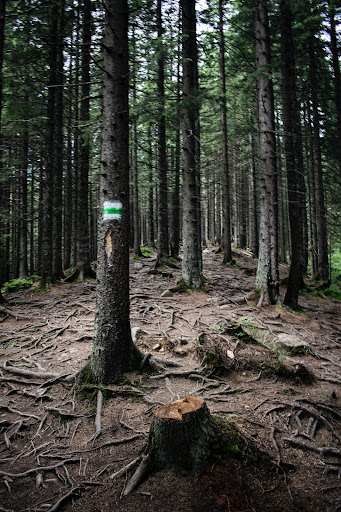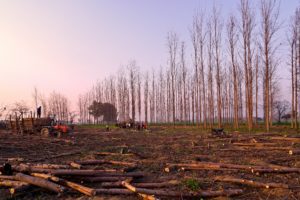Many landowners in Maine and New Hampshire simply let their timber lots grow wild and get them harvested every 10 to 30 years without ever considering hiring a forester to provide forestry services. In many ways, this is adequate for landowners with a few acres of wood behind their homestead. However, as lots get larger and more trees are involved, the complexity of the management grows as well. It’s usually agreed to be around the 10-acre mark that a forester to manage the wood lot goes from “nice to have” to “essential” for any kind of meaningful success.
What Forestry Services Do Foresters Perform For Landowners?
Foresters provide a wide range of specific and general services for landowners at every stage of a timber investment. From finding, vetting, and acquiring a timber lot, to management planning and execution, to planning, organizing, and overseeing harvest operations.
The following ten services aren’t mutually exclusive, as with most ecological trades, forestry services are interconnected, and overlap as no element of a forest is really isolated from any other. These ten forestry services are the ones that landowners most commonly seek out foresters to help with, though.
1. Timber Management: Foresters help owners develop and implement a plan for managing their timberland, including activities such as planting, thinning, and harvesting trees. This is the most iconic of forestry services.
Timber management refers to the practice of planning and overseeing the cultivation, harvesting, and use of trees and forests for a variety of purposes, including the production of timber, the conservation of natural resources, and the protection of wildlife habitat. Foresters, or forestry professionals, are trained in the principles and techniques of timber management and are responsible for helping landowners and resource managers develop and implement plans to sustainably manage their forests.
Some specific activities that foresters may be involved in as part of timber management include:
- Planting: Foresters may help landowners plan and carry out the planting of trees to reforest an area, restore a degraded forest, or create a new forest.

Regardless of the type of harvest, forestry services like forest management bring big benefits to landowners.
- Thinning: Foresters may recommend thinning, or the selective removal of trees, to promote the growth and health of the remaining trees and improve the overall structure of the forest.
- Harvesting: Foresters may assist with the planning and execution of timber harvesting operations, ensuring that trees are harvested in a sustainable and responsible manner.
- Conservation: Foresters may also be involved in conservation efforts to protect forests and their associated ecosystems, including developing land management plans that consider the needs of both the forest and the wildlife that depend on it.
2. Timber Marketing: Foresters assist owners in identifying potential buyers for their timber and negotiating sales contracts.
Timber marketing refers to the process of identifying potential buyers for timber and negotiating sales contracts. Foresters, or forestry professionals, may be involved in this process as part of their role in helping landowners manage their forests and timber resources.
Some specific activities that foresters may be involved in as part of timber marketing include:
- Identifying potential buyers: Foresters may assist landowners in identifying potential buyers for their timber, including logging companies, sawmills, and other wood product manufacturers.
- Conducting timber cruises: Foresters may conduct timber cruises, or the measurement and assessment of the volume and quality of timber on a property, to provide information to potential buyers and help determine the value of the timber.
- Negotiating sales contracts: Foresters may help landowners negotiate sales contracts with buyers, including the terms of the sale, the price of the timber, and any provisions for the logging or harvesting of the timber.
- Advertising timber sales: Foresters may also be involved in advertising timber sales to potential buyers, including preparing bid prospectuses that detail the terms and conditions of the sale and circulating them to potential bidders.
Overall, the goal of timber marketing is to help landowners sell their timber in a way that maximizes the value of their resources and achieves their financial and management objectives. Foresters can provide valuable expertise and assistance in this process, helping landowners navigate the complex factors that can impact the value of their timber and negotiate the best possible terms for their sales.
3. Timber Valuation: Foresters use their expertise to estimate the value of a timberland owner’s trees and timber.
Timber valuation refers to the process of estimating the value of a landowner’s trees and timber, typically for the purpose of making informed decisions about the management and use of the forest resource. Foresters, or forestry professionals, are trained in the principles and techniques of timber valuation and are often involved in this process as part of their role in helping landowners manage their forests.
There are several methods that foresters may use to value timber, including:
- Timber cruises: Timber cruises involve measuring and assessing the volume and quality of timber on a property in order to determine its value. Foresters may conduct timber cruises as part of the valuation process, using specialized tools and techniques to accurately measure and assess the timber resource.
- Timber stand typing: Timber stand typing involves classifying a forest into different stand types based on the dominant tree species, age, size, and other characteristics. This information can be used to estimate the value of the timber based on market demand and other factors.
- Market analysis: Foresters may also consider market conditions and trends when valuing timber, including the demand for different types of wood products, the location of the property relative to markets and transportation routes, and other factors that can impact the value of the timber.
Overall, the goal of timber valuation is to provide landowners with accurate and objective information about the value of their timber resource, which can be used to make informed decisions about its management and use. Foresters can provide valuable expertise and assistance in this process, helping landowners understand the value of their timber and make informed decisions about its management.
4. Timber Cruises: Foresters conduct surveys of timberland to determine the volume, quality, and species of trees present on the property.
Timber cruises are surveys of a forest or timberland property conducted by a forester or other forestry professional to determine the volume, quality, and species of trees present on the property. These surveys are typically conducted using statistical sampling methods, in which a representative sample of trees is measured and assessed in order to estimate the overall volume and value of the timber resource.
There are two main types of timber cruises: timber cruises and inventory cruises. Timber cruises are typically conducted before harvesting a stand of trees and are used to estimate the volume of different products that can be produced from the timber, such as pulpwood and saw timber. Inventory cruises, on the other hand, are typically conducted at specific ages in a stand’s life and are used to estimate the volume of timber that will be available in the future.
During a timber cruise, a forester will typically measure the diameter and height of trees in a sample plot, as well as classify each tree according to its species and product class. The data collected during the cruise is then used to estimate the volume and value of the timber resource, which can be used to inform forest management and harvest planning decisions.
Timber cruises are an important tool for forestry professionals and landowners as they provide valuable information about the timber resource, which can be used to make informed decisions about its management and use. Foresters are trained in the principles and techniques of timber cruising and are typically responsible for conducting these surveys and analyzing the resulting data.
5. Timber Stand Improvement: Foresters help landowners improve the health and productivity of their timberland through forestry services such as weed control, prescribed burns, and pest management.
Timber stand improvement (TSI) is a term used to describe a range of practices that aim to improve the health, productivity, and quality of a forest stand. These practices can include activities such as prescribed burns, weed control, pest management, and the removal of lower-quality trees to allow crop trees to fully use growing space. TSI practices may be used at different times throughout the life of a stand, from the establishment of a new crop of trees to the final harvest.
The main goal of TSI is to continue the production of high-quality timber products, and these practices can be used to convert lower-quality stands into faster-growing and more productive forests of desirable species. Some TSI practices, such as thinning, can also generate income if the trees being removed are merchantable. Foresters can help landowners develop and implement a TSI plan that is tailored to the specific needs and goals of their property.
6. Reforestation: Foresters assist landowners in planting new trees to replace those that have been harvested or lost due to natural causes.
Reforestation is the planting of new trees in an area where forests have been destroyed, either through natural causes or human activities such as logging or land development. Reforestation is important for several reasons.
Trees absorb carbon dioxide from the atmosphere as they grow, which helps to mitigate the greenhouse effect and combat climate change. Forests also provide a habitat for various plant and animal species and are an important source of timber and other forest products.
Reforestation can help to restore degraded land and improve soil quality, as well as provide recreational and cultural benefits for local communities. In some cases, reforestation may be necessary to restore a damaged or destroyed ecosystem. Still, in many regions, including much of New England, natural regeneration of forests is sufficient, and reforestation is not needed.
7. GIS Mapping: Foresters use geographic information systems (GIS) technology to create detailed maps of timberland properties, including information on tree species, location, and size.

GIS software is far more advanced and flexible than traditional cartographic tools
In forestry, GIS mapping creates detailed maps of timberland properties, including information on tree species, location, and size. This information is used for various purposes, such as resource management, land use planning, and timber valuation.
Foresters can use GIS mapping to create a detailed inventory of a property’s trees, including their size, species, and location. This information can be used to determine the timber volume on a property, as well as the market value of the trees.
GIS mapping can also be used to identify areas of the property that are suitable for reforestation versus natural regeneration or areas that may need timber stand improvement.
Overall, GIS mapping is a valuable tool for foresters as it allows them to create detailed and accurate maps of timberland properties, which can be used to inform land management decisions and optimize the use of resources.
8. Timberland Acquisition and Divestiture: Foresters assist owners in buying or selling timberland properties.

Some opportunities are easy to miss.
Timberland acquisition refers to the process of buying timberland properties, which are areas of land that are primarily used for growing trees and other forestry products.
Foresters can assist owners in this process by providing due diligence services, such as wood flow projections, timber resource valuation, and GIS analysis. These services help potential buyers to assess the potential of the land and ensure that it meets their goals and offers value for the investment.
Timberland divestiture refers to the process of selling timberland properties. Foresters can assist owners in this process by helping to market the property, evaluating the timber resources, and negotiating the sale. They may also be involved in transitioning management responsibilities to the new owner.
9. Timberland Investment Analysis: Foresters provide financial analysis and advice to help owners make informed decisions about investing in timberland.
Many large investors contract with foresters like Tall Pines Forest Management to analyze how profitable a particular timber investment can be. This often means using the same tools and strategies as with other timber management practices, including GIS analysis.
Some examples of timberland investment options include:
- Individual ownership: Investors can purchase a piece of land and manage it themselves or hire a professional forester to manage it for them.
- Timberland investment trusts: These trusts hold timberland and use the proceeds from the sale of the timber to pay dividends to investors.
- Timber REITs: Real estate investment trusts (REITs) focused on timberland properties. These REITs own, manage, and sell timberland properties and pay dividends to shareholders.
- Timber mutual funds: Mutual funds that invest in companies involved in the production, distribution, and sale of timber products.
When considering a timberland investment, it’s important to understand the potential risks and rewards. Some factors to consider include the location and type of timberland, the potential for timber price appreciation, and the potential for natural disasters or pests to affect the land. Foresters can provide financial analysis and advice to help investors make informed decisions about investing in timberland.
10. Forest Stewardship Planning: Foresters help landowners develop and implement plans to manage their timberland in an environmentally responsible manner.
Forest stewardship planning is a process in which foresters work with landowners to develop a plan for managing their timberland responsibly and sustainably. This involves considering the various resources present on the land, including timber, wildlife, soil, water, recreational opportunities, and natural beauty, and developing management objectives that take these resources into account.
The goal of forest stewardship planning is to ensure that the land is managed in a way that meets the needs of the current owner while also preserving the land for future generations. This may involve a variety of management strategies, such as timber harvesting, wildlife habitat management, restoration efforts, and more.
To develop a forest stewardship plan, foresters typically work with landowners to assess the current condition of the land, identify the landowner’s goals and objectives, and develop a plan that takes these factors into account. The plan may include recommendations for specific management activities, as well as guidance on how to implement and monitor the plan over time.
In addition to helping landowners develop a forest stewardship plan, foresters may also provide assistance with implementing the plan and monitoring its progress. This may involve providing technical advice, coordinating with other professionals and agencies, and assisting with implementing specific management activities.
Overall, the goal of forest stewardship planning is to help landowners manage their timberland in a way that is environmentally responsible and sustainable while also meeting their goals and objectives. By working with a forester, landowners can gain valuable insights and expertise that can help them effectively manage their land for the long term.
Working with Tall Pines Forest Management
At Tall Pines, we love helping our clients achieve their timberland goals with extensive services and hands-on customer support. If any of these services are something you now realize you need, please reach out to us to learn more about what you might need help with and how we can be of assistance.



0 Comments